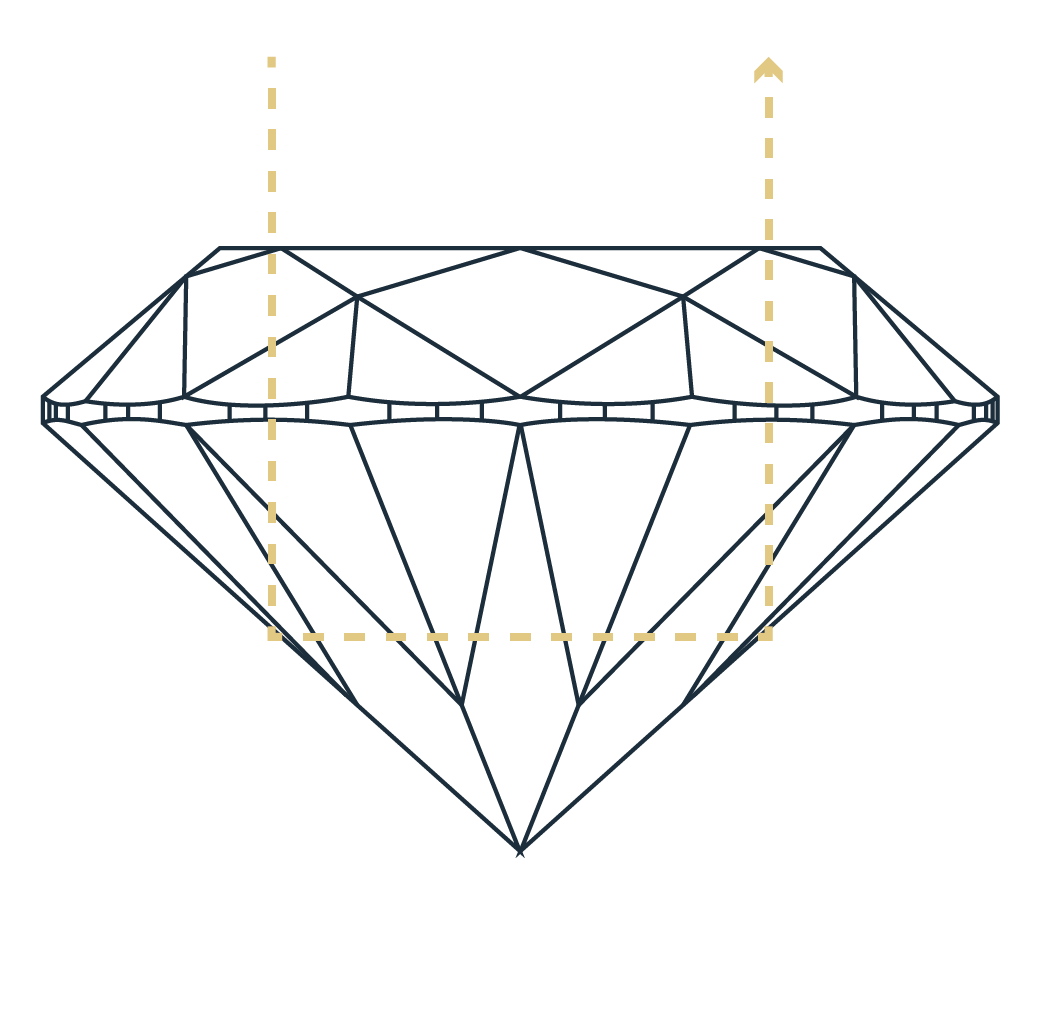Cut identify how closely the diamond has been cut and polished to ideal proportions.
A diamond's cut is not only about its shape, but how effectively the stone can return
light back to the viewer's eye. A well-cut diamond will be seen as brilliant and
sparkling. A poorly cut diamond may have the highest color and perfect clarity yet
it will look dark and lifeless.
Not only do well-cut diamonds appear more brilliant, they can also appear larger
than other stones of the same carat weight. An ideal stone has both increased brilliance
as well as increased diameter relative to more deeply cut diamonds.
The Path Of Light In 3 Differently Proportioned Diamonds

"SHALLOW-CUT" DIAMOND
Much light leaks out of the pavilion causing the diamond to appear "washed-out", or "watery"

"WELL-CUT" DIAMOND
The Majority of light returns to the eye exhibiting a Balance of Brilliance, Dispersion, Scintillation and Luster

"DEEP-CUT" DIAMOND
Much light leaks out of the pavilion causing the diamond to appear dark. Extreme examples are called "Nail-heads"
When a diamond is cut to the proper proportions and is finished well, light refracts
into the diamond, is reflected from one facet to another and then returns through
the top of the gem resulting in a display of brilliance (white light), dispersion
(rainbow-colored light) and scintillation (sparkling when the diamond moves), and
luster (bright reflections from the surface). Proper cutting is the key to a diamond's
beauty and value.
Most diamond shapes are cut with 58 facets, or separate flat surfaces, according
to mathematical formulas. Using symmetry, the cutter aligns these facets at precise
angles in relation to each other to maximize the reflection and refraction of light.
The proportions are calculated in angles & percentages that show how well the diamond
refracts and reflects light.
A Diamond’s anatomy

Crown
The area of the diamond above the girdle.
Girdle
The girdle is the outer edge of the diamond. It is rated
in terms of thickness ranging from thin to thick: Extremely Thin, Very Thin, Thin,
Medium, Slightly Thick, Thick, Very Thick, or Extremely Thick. When purchasing a
diamond, avoid Extremely Thin or Extremely Thick. The girdle usually has a frosted
appearance. Many diamonds are also finished with a fully polished or even a faceted
girdle, depending on the cutter's preference. This will not affect the diamond's
value.
Pavilion
The bottom part from the girdle to the culet.
Culet
The culet is the bottom point of the diamond. In many cases,
this point actually has a very small facet. The culet is graded according to the
presence or size of this facet: None or Pointed, Very Small, Small, Medium, Slightly
Large, Large, Very Large and Extremely Large. The more desirable culets are graded
from none to small
Polish
This characteristic refers to the finishing or final polishing
of the facets, or flat surfaces. Each facet should be carefully fashioned by the
diamond cutter to shine and be free from polishing imperfections that can dull the
diamond. The polish of a diamond is generally defined as: Poor, Fair, Good, Very
Good, or Excellent. When purchasing a diamond, generally the rarer color and clarity
diamonds are also well polished. Contrary to common belief, diamonds are ground
and polished, not chipped away, until they reach their final form.
Analyzing Cut
To understand the sub-categories for well-cut diamonds, think of a pyramid with
"Ideal" at the top. This narrow range is reserved for the most brilliant, rare and
valuable diamonds. The "Excellent" range includes beautiful diamonds that return
almost as much light. "Very Good" represents the balance between precise proportions
and price considerations.

Each Diamond Part Has A Function:
Crown: Balance, Brilliance, Dispersion, and Scintillation
Girdle: Provide a Setting Edge for the gem
Pavilion: Reflect light back up through the crown
Culet: Prevent Chipping at the tip